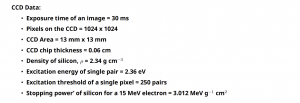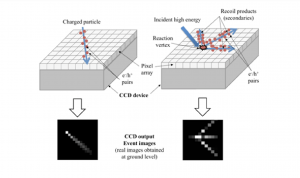2021年IOAA理论第13题-Lucy:第一个去往特洛伊小行星的任务
英文题目
CCD cameras on space probes are very sensitive and exposed to space weather conditions. Intense radiation passing through the CCD produces electron-hole pairs in the silicon of the CCD chip. The rate at which these pairs are produced is an important parameter when operating cameras on board spacecraft and can be calculated for radiation of any given energy.
A high energy particle or photon of radiation passing through the CCD will deposit some energy in the chip with each electron-hole pair it creates. The ‘stopping power’ of silicon for a given type of particle can be measured as the energy per areal density ($$𝑎𝑟𝑒𝑎𝑙 𝑑𝑒𝑛𝑠𝑖𝑡𝑦 = 𝑚𝑎𝑠𝑠 𝑝𝑒𝑟 𝑢𝑛𝑖𝑡 𝑎𝑟𝑒𝑎$$) that the silicon ‘takes away’ from the travelling particle.
NASA's Lucy mission will be the first to study the Trojan asteroids and will revolutionize our understanding of the formation of the Solar System. One of the instruments on board is L'LORRI (Lucy LOng Range Reconnaissance Imager), which contains a sensitive CCD in order to produce detailed images of the Trojan asteroids. Unfortunately, the radiation around Jupiter is very intense and it can generate a lot of ‘noise’ in the pixels of the CCD.
Let us assume that an average charged particle trapped in Jupiter's magnetic field has an energy of $$15 𝑀𝑒𝑉$$ and that the flux of such particles in this region is equivalent to about 600 electrons $$s^{-1}\cdot cm^{-2}$$ . Also assume that for each electron-hole pair which a particle passing through a pixel creates, it deposits exactly the excitation energy of the pair in that pixel. After the pixel crosses a threshold number of electron-hole pairs it is ‘excited’ and no more pairs can be produced in that pixel. Any remaining energy in the particle is passed to the next pixel (and so on).
Using the data given below for the CCD chip in the L’LORRI camera, answer the following questions:
13.1 How many pixels will be excited by one such particle of radiation passing through the CCD when the spacecraft is near Jupiter's orbit?(10.0pt)
13.2 Given the radiation flux near Jupiter, what percentage of the total number of pixels in an image will be excited?(5.0pt)

